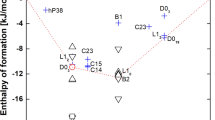Abstract
The effect of Li addition on the slip behavior of Mg has been investigated using a molecular dynamics simulation. Based on a previous study on Mg–Y alloys concluding that a reduction of the anisotropy in critical resolved shear stress (CRSS) among difference slip systems activates the \( \left\langle {\text{c}} + {\text{a}} \right\rangle \) slip, the effect of Li, an element known to improve the room temperature ductility of Mg is chosen as an alloying element to examine the robustness of the above-mentioned conclusion. It is found that Li increases the CRSS of the basal slip more than that of the non-basal slip, reducing the difference in the CRSS among different slip systems. The reduced anisotropy in CRSS is believed to activate the non-basal \( \left\langle {\text{c}} + {\text{a}} \right\rangle \) slip and eventually improve ductility in Mg–Li alloys. This understanding can be further extended into an alloy design of more cost-effective Mg alloys with improved room temperature formability.
Similar content being viewed by others
References
J. Zhang, S.P. Joshi, Phenomenological crystal plasticity modeling and detailed micromechanical investigations of pure magnesium. J. Mech. Phys. Solids 60(5), 945–972 (2012)
G.I. Taylor, Plastic strain in metals. J. Inst. Metals 62, 307 (1938)
S. Sandlobes et al., The relation between ductility and stacking fault energies in Mg and Mg–Y alloys. Acta Mater. 60, 3011–3021 (2012)
S.R. Agnew, M.H. Yoo, C.N. Tome, Application of texture simulation to understanding mechanical behavior of Mg and solid solution alloys containing Li or Y. Acta Mater. 49, 4277–4289 (2001)
F. Kang et al., The activation of <c + a> non-basal slip in Magnesium alloys. J. Mater. Sci. 47, 7854–7859 (2012)
Z. Pei et al., Ab initio and atomistic study of generalized stacking fault energies in Mg and Mg–Y alloys. New J. Phys. 15, 043020 (2013)
W.Y. Wang et al., Effects of Alloying elements on stacking fault energies and electronic structures of binary Mg alloys: a first-principles study. Mater. Res. Lett. 2(1), 29–36 (2014)
S. Sandlobes et al., On the role of non-basal deformation mechanisms for the ductility of Mg and Mg–Y alloys. Acta Mater. 59, 429–439 (2011)
K.-H. Kim, J.B. Jeon, B.-J. Lee, Role of yttrium in activation of <c + a> slip in magnesium: an atomistic approach. Scr. Mater. 108, 104–108 (2015)
T. Al-Samman, Comparative study of the deformation behavior of hexagonal magnesium–lithium alloys and a conventional magnesium AZ31 alloy. Acta Mater. 57, 2229–2242 (2009)
J. Han, X.M. Su, Z.-H. Jin, Y.T. Zhu, Basal-plane stacking-fault energies of Mg: a first-principles study of Li- and Al-alloying effects. Scr. Mater. 64, 693–696 (2011)
M. Muzyk, Z. Pakiela, K.J. Kurzydlowski, Generalized stacking fault energy in magnesium alloys: density functional theory calculation. Scr. Mater. 66, 219–222 (2012)
Y.-M. Kim, I.-H. Jung, N.J. Kim, B.-J. Lee, Atomistic modeling of pure Li and Mg–Li system. Modell. Simul. Mater. Sci. Eng. 20, 035005 (2012)
M.I. Baskes, Modified embedded-atom potentials for cubic materials and impurities. Phys. Rev. B 46(5), 2727–2742 (1992)
B.-J. Lee, M.I. Baskes, Second nearest-neighbor modified embedded-atom-method potential. Phys. Rev. B 62(13), 8564–8567 (2000)
Y.-M. Kim, N.J. Kim, B.-J. Lee, Atomistic modeling of pure Mg and Mg-Al systems. CALPHAD: Comput. Coupling Phase Diagrams Thermochem. 33, 650–657 (2009)
K.-H. Kim, J.B. Jeon, B.-J. Lee, Modified embedded-atom method interatomic potentials for Mg–X (X=Y, Sn, Ca) binary systems. CALPHAD: Comput. Coupling Phase Diagrams Thermochem. 48, 27–34 (2015)
Y.N. Osetsky, D.J. Bacon, An atomic-level model for studying the dynamics of edge dislocations in metals. Modell. Simul. Mater. Sci. Eng. 11(4), 427–446 (2003)
S. Plimpton, Fast parallel algorithms for short-range molecular dynamics. J. Comput. Phys. 117, 1–19 (1995)
S.R. Agnew, J.A. Horton, M.H. Yoo, Transmission electron microscopy investigation of <c + a> dislocations in Mg and α–solid solution Mg-Li alloys. Metall. Mater. Trans. A 33(A), 851–858 (2002)
S.R. Agnew, O. Duygulu, Plastic anisotropy and the role of non-basal slip in magnesium alloy AZ31B. Int. J. Plast. 21, 1161–1193 (2005)
Author information
Authors and Affiliations
Corresponding author
Editor information
Editors and Affiliations
Rights and permissions
Copyright information
© 2017 The Minerals, Metals & Materials Society
About this paper
Cite this paper
Jang, HS., Kim, KH., Kim, N.J., Lee, BJ. (2017). Understanding on the Role of Rare Earth Elements in Activation of \( \left\langle {\text{c}} + {\text{a}} \right\rangle \) Slip in Magnesium: An Atomistic Approach. In: Solanki, K., Orlov, D., Singh, A., Neelameggham, N. (eds) Magnesium Technology 2017. The Minerals, Metals & Materials Series. Springer, Cham. https://doi.org/10.1007/978-3-319-52392-7_67
Download citation
DOI: https://doi.org/10.1007/978-3-319-52392-7_67
Published:
Publisher Name: Springer, Cham
Print ISBN: 978-3-319-52391-0
Online ISBN: 978-3-319-52392-7
eBook Packages: Chemistry and Materials ScienceChemistry and Material Science (R0)




